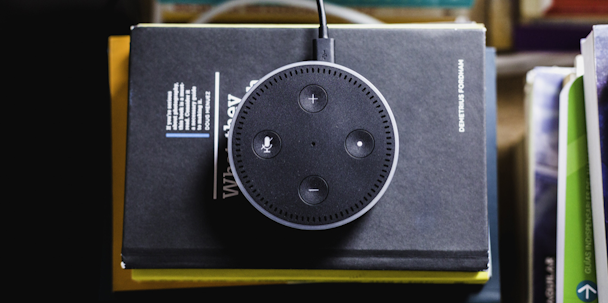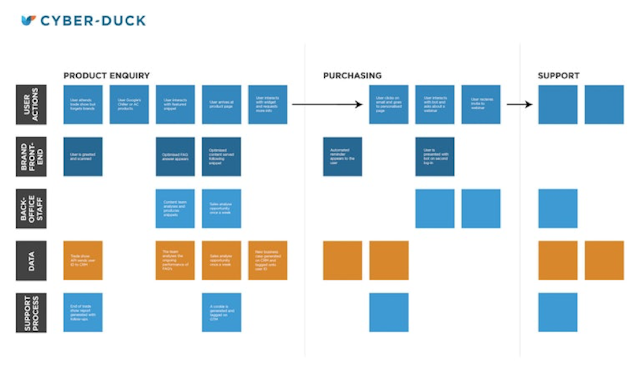AI and UX go hand-in-hand: putting your user at the heart of the process
Many prominent thinkers have warned of the risks inherent in AI. However, they also point to its vast potential to free us from mundane tasks, to gain deeper insights and to boost productivity.

There’s no doubt that AI has huge potential to improve our everyday lives – at least before the robots take over. Because it already has, and for decades. We can thank AI for Deep Blue, the first computer chess playing program, for driverless cars and, speaking personally, for Microsoft email spam filters.
Today, AI is powering genetic testing and computer vision in healthcare; risk assessment and fraud detection in financial services; even easing and automating government services.
Why AI and UX?
AI is complex and it’s not cheap, so how can you focus on the opportunities that’ll help your business?
That’s where UX can help. Putting your user at the heart of the process means you’ll develop experiences that put their interests first, protect their data and ensure you’re interacting with them with integrity and authenticity.
With tools like service blueprints, you can home in on the points in your customer journeys where AI can add the most value – and justify your investment.
So how can we do this? Let’s start with some principles.
1. Look for opportunities to automate
What can be automated? Anything that takes less than five seconds to compute. Use user centered design (UCD) to research user behaviour and service design blueprints to identify the points in your customer journeys where AI can improve the experience.

2. Get your data together
There’s no point implementing AI without proper data science, data collection and data cleansing, otherwise you can’t deliver and measure its impact.
3. Personalise the experience
What do your customers want? Can AI connect the dots for them? For example, if I haven’t logged in to check my mortgage for a while and I made an enquiry with the mortgage company over the phone, should the system make content and feature suggestions to me based on that behaviour when I next visit the website? UX can reveal common-sense applications for AI.
4. Add value
Using API-driven design, we can add value with chatbots and personal assistants to access our products and services – like Cyber-Duck’s UX Companion Alexa skill.
AI needs careful planning, like this GP appointment booking system designed at a Cyber-Duck hackathon.
5. Practice what you preach
As product and UX designers, we can use tools like AI assistant Otter to augment transcripts. AI can even generate code in real time using TensorFlow machine learning blended with computer vision image recognition.
6. Don’t freak out your user
With power comes responsibility. When you’re testing AI experiences, ask users if they’re comfortable with them. Remove anything creepy and watch out for regulation – AI shouldn’t decide which candidates to invite to job interviews, for example, because GDPR gives applicants a “right of explanation” for any algorithmic output based on their data. This is where ethics begin.
Once you’ve got your principles straight, then it’s time to get to strategic. AI needs to be implemented in a way that’s thoughtful, ethical, robust and user-centred.
Your AI playbook
- Pilot projects – start small and with experimentation to gain momentum. Fail, learn and restart. Use short sprints to drive success. You will need to partner with a software engineer that has experience using AI frameworks.
- Build an AI team – while it's fine to outsource AI, you will need to build internal capability. You must get buy-in from the C-suite for not only AI but also the data science that supports it.
- Training - you will then need broad AI training for the team so your colleagues are educated on AI and understand its capability.
- Research – hold a service design workshop to establish the core product – user journeys, touchpoints, initial UI and data flow. Evaluate any risks. Human bias, for example, can be replicated and even amplified by AI. UX designers are primed for this sort of work.

- Framework – consider what software or frameworks you’ll use. You’ll want to ensure compatibility and support. We use Azure and AWS.
- Gap analysis – conduct an audit and gap analysis of data and existing systems.
- Data warehouse – design your data warehouse to cover ingestion, storage, processing, analytics, output and how data is processed by the application.
- Strategy – once you’ve run your pilots and are happy with your setup, you’re ready to layer AI into your experiences. Consider your business objectives and customer needs. What’s the end goal? How can AI support it?
- Regular reviews - once it’s set up, you’ll want to monitor AI to ensure it’s providing value. Review your workflows each week. Then tweak, test and adapt your experiences.
Ethics
People are right to be concerned about AI. Its potential, especially in the medium to long term, once AI thinking outstrips human intelligence, does carry risk. The Turing Institute’s Data Ethics Group is leading the way in understanding the ethics and implications of AI and working with the likes of the NHS on codes of conduct.
That’s important, because the people warning us to be cautious around AI are right: we are entering a brave new world. But that doesn’t take away from its potential to save us time, give us better insights and guide us towards better decisions.
Because UX puts your customers at the centre of designed experiences, it can help flag any problem areas or uncomfortable elements in an AI experience. If AI is your exciting new friend taking you on a crazy night out, then UX is the longstanding BFF who’ll make sure you all get home safely and securely.
If you’d like to read more about implementing AI and other time-saving technologies, our UX Handbook is packed with practical advice and tips. As for me, I’m off to set up a bot to cut down my admin. If only it could take care of my commute for me too…
Content by The Drum Network member:

Cyber-Duck
Established in 2005, Cyber-Duck is a leading digital agency that works with exciting startups and global brands such as Cancer Research Technology, The European...
Find out more
